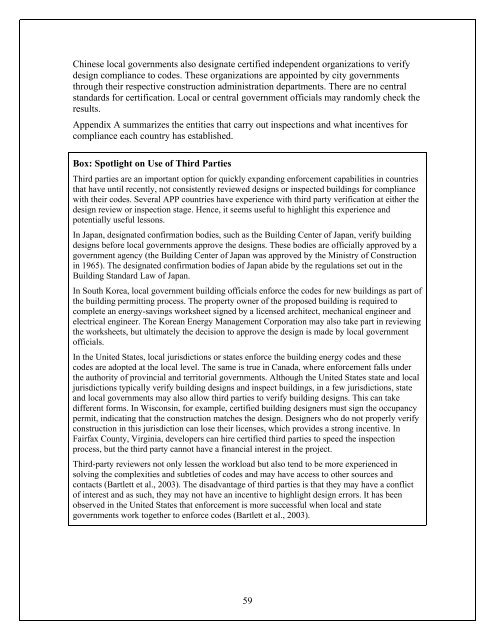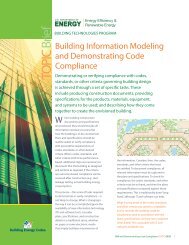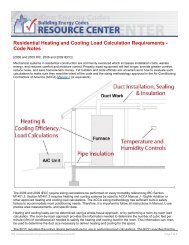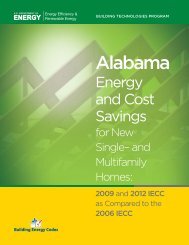Japan only supervises <strong>the</strong> build<strong>in</strong>g design, and does not <strong>in</strong>spect build<strong>in</strong>gs forenergy code issues. Ch<strong>in</strong>a relies heavily on third parties, both <strong>in</strong> <strong>the</strong> design review and <strong>in</strong> <strong>in</strong>spections. India does not enforce its voluntary code. S<strong>in</strong>ce state and local governmentswould need to adopt <strong>the</strong> code for it to become mandatory, <strong>the</strong>se governmentswould likely have a large role <strong>in</strong> enforcement, as <strong>the</strong>y do with o<strong>the</strong>r build<strong>in</strong>g codeissues. Several APP countries provide penalties and <strong>in</strong>centives to encourage codecompliance. Common consequences for non-compliance <strong>in</strong>clude prohibit<strong>in</strong>g aproperty owner from occupy<strong>in</strong>g a build<strong>in</strong>g, publish<strong>in</strong>g <strong>the</strong> names of noncompliantproperty owners and issu<strong>in</strong>g f<strong>in</strong>es. Rewards for compliance commonly<strong>in</strong>volve one or more of <strong>the</strong> follow<strong>in</strong>g: monetary awards, relaxation of zon<strong>in</strong>grequirements for a build<strong>in</strong>g, low <strong>in</strong>terest rates from banks and o<strong>the</strong>r lend<strong>in</strong>g<strong>in</strong>stitutions, and tax benefits.Strong build<strong>in</strong>g codes are an effective and low-cost approach to improve energyefficiency. However, without str<strong>in</strong>gent enforcement by officials and compliance from <strong>the</strong>construction <strong>in</strong>dustry, build<strong>in</strong>g codes do not deliver <strong>the</strong> promised energy sav<strong>in</strong>gs.Enforcement of build<strong>in</strong>g codes encompasses several stages of build<strong>in</strong>g construction andis carried out by different bodies of government or <strong>the</strong> private sector. The first element ofenforcement or po<strong>in</strong>t of control is at <strong>the</strong> design stage. All APP countries except Indiahave local governments oversee this stage, albeit to different degrees (India’s code isvoluntary, so <strong>the</strong>re is no enforcement framework currently). In most cases, this meansthat local governments oversee <strong>the</strong> process and conduct <strong>the</strong> actual reviews. This is true <strong>in</strong>Australia, Canada, South Korea, Japan and <strong>the</strong> United States. South Korea, Japan and <strong>the</strong>United States also <strong>in</strong> some cases allow third parties to verify designs, although <strong>in</strong> mostsuch cases, local governments review <strong>the</strong> verification of <strong>the</strong> designs. For example, <strong>in</strong>South Korea, <strong>the</strong> Korea <strong>Energy</strong> Management Corporation may be asked to verify designsfor local governments. In Japan, local governments review and approve all build<strong>in</strong>gdesigns. However, third parties, referred to as “designated confirmation bodies,” firstvalidate build<strong>in</strong>g designs (Cab<strong>in</strong>et Office of Japan 2006).Enforcement is just as crucial dur<strong>in</strong>g build<strong>in</strong>g construction and before a build<strong>in</strong>g iscertified for occupancy. Local governments <strong>in</strong> Australia, Canada, South Korea and <strong>the</strong>United States perform build<strong>in</strong>g <strong>in</strong>spections. With small build<strong>in</strong>gs, <strong>in</strong>spections willtypically take place twice: once dur<strong>in</strong>g construction (before <strong>the</strong> <strong>in</strong>terior walls are sealed)and once before <strong>the</strong> build<strong>in</strong>g is put <strong>in</strong>to operation. Large build<strong>in</strong>gs, on <strong>the</strong> o<strong>the</strong>r hand,may require a series of <strong>in</strong>spections as construction takes place at different paces <strong>in</strong>different stories of <strong>the</strong> build<strong>in</strong>g. In Japan, <strong>the</strong>re are no <strong>in</strong>spections for build<strong>in</strong>g energycode requirements. Ch<strong>in</strong>a relies primarily on third party entities for <strong>in</strong>spections and <strong>the</strong>reis typically one <strong>in</strong>spection. India does not yet enforce its code. In <strong>the</strong> United States, Ch<strong>in</strong>aand o<strong>the</strong>r countries <strong>the</strong>re is a grow<strong>in</strong>g effort to verify and document compliance rates.For example, <strong>in</strong> <strong>the</strong> United States, recent legislation sets a goal of 90% enforcement of<strong>the</strong> build<strong>in</strong>g energy codes, and <strong>the</strong> U.S. Department of <strong>Energy</strong> is develop<strong>in</strong>g detailedmethodologies for track<strong>in</strong>g compliance rates.58
Ch<strong>in</strong>ese local governments also designate certified <strong>in</strong>dependent organizations to verifydesign compliance to codes. These organizations are appo<strong>in</strong>ted by city governmentsthrough <strong>the</strong>ir respective construction adm<strong>in</strong>istration departments. There are no centralstandards for certification. Local or central government officials may randomly check <strong>the</strong>results.Appendix A summarizes <strong>the</strong> entities that carry out <strong>in</strong>spections and what <strong>in</strong>centives forcompliance each country has established.Box: Spotlight on Use of Third PartiesThird parties are an important option for quickly expand<strong>in</strong>g enforcement capabilities <strong>in</strong> countriesthat have until recently, not consistently reviewed designs or <strong>in</strong>spected build<strong>in</strong>gs for compliancewith <strong>the</strong>ir codes. Several APP countries have experience with third party verification at ei<strong>the</strong>r <strong>the</strong>design review or <strong>in</strong>spection stage. Hence, it seems useful to highlight this experience andpotentially useful lessons.In Japan, designated confirmation bodies, such as <strong>the</strong> Build<strong>in</strong>g Center of Japan, verify build<strong>in</strong>gdesigns before local governments approve <strong>the</strong> designs. These bodies are officially approved by agovernment agency (<strong>the</strong> Build<strong>in</strong>g Center of Japan was approved by <strong>the</strong> M<strong>in</strong>istry of Construction<strong>in</strong> 1965). The designated confirmation bodies of Japan abide by <strong>the</strong> regulations set out <strong>in</strong> <strong>the</strong>Build<strong>in</strong>g Standard Law of Japan.In South Korea, local government build<strong>in</strong>g officials enforce <strong>the</strong> codes for new build<strong>in</strong>gs as part of<strong>the</strong> build<strong>in</strong>g permitt<strong>in</strong>g process. The property owner of <strong>the</strong> proposed build<strong>in</strong>g is required tocomplete an energy-sav<strong>in</strong>gs worksheet signed by a licensed architect, mechanical eng<strong>in</strong>eer andelectrical eng<strong>in</strong>eer. The Korean <strong>Energy</strong> Management Corporation may also take part <strong>in</strong> review<strong>in</strong>g<strong>the</strong> worksheets, but ultimately <strong>the</strong> decision to approve <strong>the</strong> design is made by local governmentofficials.In <strong>the</strong> United States, local jurisdictions or states enforce <strong>the</strong> build<strong>in</strong>g energy codes and <strong>the</strong>secodes are adopted at <strong>the</strong> local level. The same is true <strong>in</strong> Canada, where enforcement falls under<strong>the</strong> authority of prov<strong>in</strong>cial and territorial governments. Although <strong>the</strong> United States state and localjurisdictions typically verify build<strong>in</strong>g designs and <strong>in</strong>spect build<strong>in</strong>gs, <strong>in</strong> a few jurisdictions, stateand local governments may also allow third parties to verify build<strong>in</strong>g designs. This can takedifferent forms. In Wiscons<strong>in</strong>, for example, certified build<strong>in</strong>g designers must sign <strong>the</strong> occupancypermit, <strong>in</strong>dicat<strong>in</strong>g that <strong>the</strong> construction matches <strong>the</strong> design. Designers who do not properly verifyconstruction <strong>in</strong> this jurisdiction can lose <strong>the</strong>ir licenses, which provides a strong <strong>in</strong>centive. InFairfax County, Virg<strong>in</strong>ia, developers can hire certified third parties to speed <strong>the</strong> <strong>in</strong>spectionprocess, but <strong>the</strong> third party cannot have a f<strong>in</strong>ancial <strong>in</strong>terest <strong>in</strong> <strong>the</strong> project.Third-party reviewers not only lessen <strong>the</strong> workload but also tend to be more experienced <strong>in</strong>solv<strong>in</strong>g <strong>the</strong> complexities and subtleties of codes and may have access to o<strong>the</strong>r sources andcontacts (Bartlett et al., 2003). The disadvantage of third parties is that <strong>the</strong>y may have a conflictof <strong>in</strong>terest and as such, <strong>the</strong>y may not have an <strong>in</strong>centive to highlight design errors. It has beenobserved <strong>in</strong> <strong>the</strong> United States that enforcement is more successful when local and stategovernments work toge<strong>the</strong>r to enforce codes (Bartlett et al., 2003).59
- Page 1 and 2:
PNNL-122267Shaping the Energy Effic
- Page 3:
Shaping the Energy Efficiency in Ne
- Page 6 and 7:
efficient air conditioning system,
- Page 8 and 9: ContentsForeword ..................
- Page 10 and 11: List of TablesTable 1 GDP, Primary
- Page 12 and 13: ForewordBuildings account for about
- Page 14 and 15: 1 Introduction and Background1.1 Im
- Page 16 and 17: esidential buildings in 2006, with
- Page 18 and 19: JAP 1. Criteria for Clients on the
- Page 20 and 21: can significantly increase energy d
- Page 22 and 23: f) South Korea’s building energy
- Page 24 and 25: 2.1 AustraliaIn the past, Australia
- Page 26 and 27: small cities will be pilot of such
- Page 28 and 29: (DCGREUH) issued by the Ministry of
- Page 30 and 31: according to the current codes. Thi
- Page 32 and 33: Table 7 Structural Comparison of Bu
- Page 34 and 35: 3.3 Building EnvelopeKey Findings A
- Page 36 and 37: JAPCCREUH1999KORBDCES2008USAASHRAE9
- Page 38 and 39: This study selects the midpoint sco
- Page 40 and 41: MiamiUSA0.36(Insulationabove deck)t
- Page 42 and 43: Six countries have jurisdictions in
- Page 44 and 45: thermal requirements for roofs, flo
- Page 46 and 47: Figure 6 Maximum U-factors in Resid
- Page 48 and 49: Table 16 HVAC in Japan’s Building
- Page 50 and 51: ItemsService water heating refers t
- Page 52 and 53: Water conservation Canada has manda
- Page 54 and 55: practice (MNECB 1997). India sets m
- Page 56 and 57: Canada and India adopt compliance p
- Page 60 and 61: 4.2 Testing and RatingKey Findings
- Page 62 and 63: Other commonly used tools among APP
- Page 64 and 65: CAN 55MNECH1997CHNINDECBCJAPCanadia
- Page 66 and 67: and local jurisdiction contact info
- Page 68 and 69: certifying third-party verifiers or
- Page 70 and 71: Point of ControlIncentives for Comp
- Page 72 and 73: Point of ControlIncentives for Comp
- Page 74 and 75: AUS,continuedCANTesting Agencies an
- Page 76 and 77: CAN,continuedCHNTesting Agencies an
- Page 78 and 79: Testing Agencies and Certification
- Page 80 and 81: USA,continuedTesting Agencies and C
- Page 82 and 83: Appendix C - Compliance SoftwareAUS
- Page 84 and 85: CANMNECB1997,continuedSoftwareMetho
- Page 86 and 87: USAIECC 2006,continuedSoftwareMetho
- Page 88 and 89: AUSBCA 2007,continuedCANMNECB1997CA
- Page 90 and 91: JAP,ContinuedKORUSAASHRAE90.1-2007T
- Page 92 and 93: AcronymsAPPAS/NZSASHRAEAUSBATFBCABD
- Page 94 and 95: ReferencesABCB (Australian Building
- Page 96 and 97: IEA (International Energy Agency).
- Page 98: OEE. 2008. Energy Use Data Handbook
















